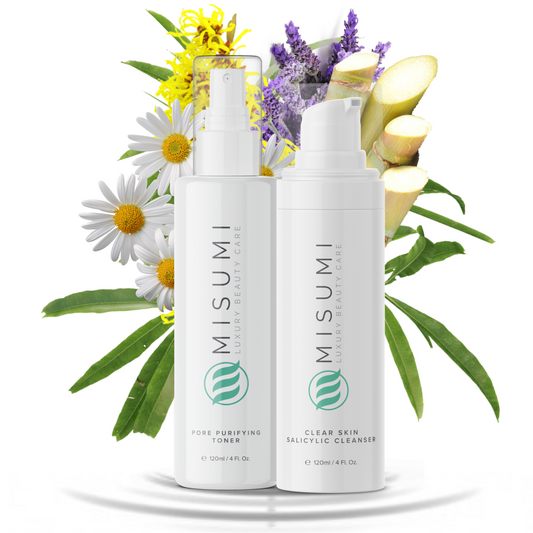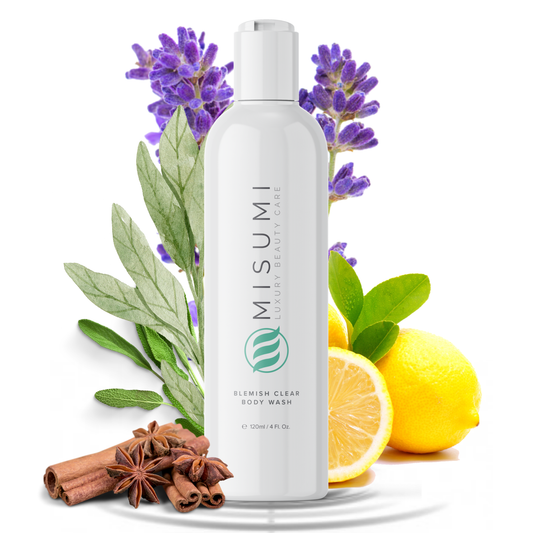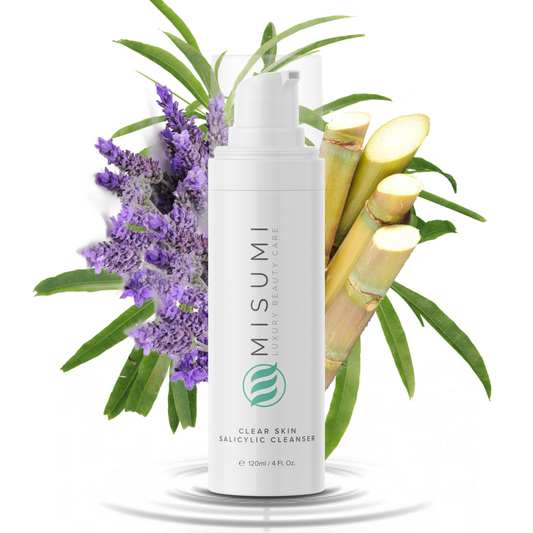Makeup is a wonderful tool which allows us to express ourselves and our unique style and creativity. Experimenting with makeup is a fun outlet which allows us to practice this amazing art form and find out what works best for our individual features and preferences.
However, there comes a point where makeup isn’t as fun as it should be. And that’s when we start to notice that certain products don’t sit well on our skin and cause different negative reactions such as breakouts, redness, irritation, and even some allergic reactions.

What are these due to? Is it makeup itself that causes our skin to break out or are there a few makeup ingredients in particular which universally cause adverse reactions on our skin?
The answer can be both. There are some people who are more sensitive to makeup than others and whose pores can become clogged up pretty easily. But, there is a consensus among the skincare community that there are some ingredients which you can probably find in most makeup products that cause our skin to break out or become irritated in some way. If you want to find out which makeup products to avoid and how to do it, just continue reading.
Parabens
You’ve probably read the label “paraben-free” at some point while you were shopping for makeup, skincare or hair products. But what are these parabens and why are they so bad for our skin?
Parabens are a type of preservative that can be found in many conventional products such as makeup, perfume, shampoos, spray tan products and moisturizers. Their main function is to prolong the shelf life of these products. They do so by preventing mold and bacteria from entering the packaging.

The most common parabens are butylparaben, methylparaben, and propylparaben.
There are some studies which link these common parabens to breast and skin cancer as well as some fertility issues. However, more studies need to be done in order to determine just how harmful parabens are.
Is it possible to avoid parabens altogether? The answer is no, unfortunately. But you can be wary of which products contain them by reading the ingredients list of your favorite products and do your best to look for labels such as “paraben-free”.
Retinyl Palmitate, Retinyl Acetate, and Retinol
Retinol or Retin A is very famous for its ability to combat acne and for its anti-aging benefits. However, when it comes to makeup, it can have the opposite effect and cause issues if you expose it to sunlight. The above-mentioned ingredients are most commonly found in lips products and moisturizers, so it’s very easy for them to become exposed to sunlight.

How can you avoid this? It’s not very practical for me to tell you to use these products only at night time since nobody applies lipstick before going to bed. But what you can do is carefully examine the lip products you frequently use and perhaps make a switch to using mineral lip products since those rarely contain chemicals such as these.
Fragrance
When it comes to fragrance, common sense tells us to keep fragrance away from our face. This particular ingredient might give a soothing scent to our products, but it can also have a negative effect on our skin and general wellbeing. Fragrances can be extremely irritating and abrasive on the skin, especially for those who have sensitive skin. They can be found in various makeup products, as well as common skincare products such as lotions and moisturizers and even some shampoos.

In terms of health risks, fragrance can disrupt our hormonal balance, which can also lead to hormonal acne. On top of that, it’s a very common allergy, but it’s quite hard to pinpoint since fragrance can be found in pretty much anything.
Opt for buying skincare and makeup products which have the “fragrance-free” label on them whenever possible in order to avoid these adverse side-effects.
Polyethylene (PEGs)
Have you ever wondered what those little plastic balls in your exfoliator are made of? Well, we have the answer. One of the ingredients they contain is polyethylene and it certainly doesn’t classify on the safe ingredients list. In fact, it’s thought to be a group 3 carcinogen, but more research needs to be done on it in order to come to a final conclusion. In addition to being present in most exfoliators, it’s a common ingredient in makeup products as well.
It’s proven that PEGs can cause major skin irritation and every person with sensitive skin should stay away from them.
Sodium Lauryl Sulfate and Sodium Laureth Sulfate (SLS/ SLES)
These ingredients can be found in various skincare and makeup products, as well as some haircare products and toothpaste. They have been known to cause negative reactions on the skin, irritation, and allergies being some of them.

Just like PEGs, these are also considered carcinogenic and professionals avoid using them whenever possible.
Triclosan
Triclosan is one of the few ingredients on this list that’s banned from using. However, it’s only prohibited in soap products and it’s still allowed to be used in cosmetics, which is quite nonsensical if you think about it. Soap can be washed off and it goes on your hands, but your makeup products stay on top of your skin for the majority of the day, making the face a rather fragile place to put harmful ingredients.
What’s scary about triclosan is that it’s an endocrine disruptor, meaning it can lead to very serious health issues such as gut problems and tumors. In mice studies, it’s been shown to promote tumor growth.
Siloxanes (Silicones)

Even though this ingredient sounds like medicine, it’s actually a synthetically manufactured compound found in a variety of skincare, hair and makeup products. And although they aren’t deemed as toxic as other ingredients on the list, they have been linked to disruptions of the endocrine system, so it’s best to avoid them as much as possible.
Unfortunately, since they’re contained in so many products, that’s not an easy task to do. The easiest way is to try and use as many natural products as you can. Natural alternatives to your favorite products might not be the easiest to find, but it’s certainly a worthwhile journey if you want the best for your skin.
Formaldehyde
Formaldehyde is found in conventional makeup and skincare products. Just like triclosan, it’s notorious for being carcinogenic, but if this isn’t enough to convince you to stay away from it, you might want to know that it’s also been linked to health issues such as asthma and neurotoxicity.

If you want to avoid these horrifying health risks, it’s wise to check your ingredients list and see if formaldehyde is there. If it is, try switching at least some of your products out.
Lead
We’ve all heard that lead is bad for us, in one form or another. But the fact that it has negative effects on our bodies doesn’t stop cosmetic companies from contaminating many makeup products such as foundation and lipstick with it.
Lead doesn’t end up in cosmetics through direct insertion into the formula, but it’s the products themselves that are contaminated with it, mostly through other ingredients such as color additives.

Its side-effects are more than frightening. Lead has been linked to fertility problems and it’s been shown to lead to miscarriages. And it makes sense that our bodies react so strongly to it since we’re exposed to lead in astronomical amounts. If you think about it, when we put foundation on our bodies, it sits on top of our face all day long and not only does the skin absorb it but we also breathe it in hours after hours.
As far as lipstick is concerned, it’s inevitable that we ingest some amount of lipstick while we eat, presuming that we have it on. Prolonged exposure to lipsticks that contain lead is dangerous for us because it’s so easy for lead to end up inside our bodies.
After learning all this information, it’s safe to assume that you’ll want to stay clear of any makeup that might be contaminated with lead. And understandably so. But how do you go about avoiding lead when it’s so easy for many products to be contaminated with it? The easiest way to avoid these products is by purchasing makeup from smaller companies and brands. In addition, you could also try using mineral and natural makeup which is made of more natural ingredients such as fruit pigments.
Lead can make its way into your life by other means too, like water, which isn’t always in your control. The good news is you can always control what you put on your skin.
Carbon Black
Ever wondered what makes eyeliner so incredibly potent? Well, it’s an ingredient known as carbon black. It’s found in most conventional eyeliners and it sneakily goes undercover by the following names as well:
- Pigment black 6
- Pigment black 7
- acetylene black
- froflow
- atlantic
- black pearls
- arrow
- arovel
- arogen
Many studies show that it’s been linked to some forms of cancer as well as organ toxicity.
Heavy Metals

Other than lead, there are other heavy metals which may cause trouble. Even though some of these are essential for normal functioning of the body, when accumulated they can cause havoc in the body. Arsenic, mercury, aluminum, zinc, iron, and chromium are some of the most commonly found heavy metals in products such as eyeliner, lipstick and nail polish.
Many health issues have been associated with a prolonged usage or exposure to heavy metals, whether they’re added directly and intentionally in the product or it’s merely contaminated with it. Problems with the immune, nervous and reproductive systems can arise if you’re undergoing heavy metal toxicity.
When it comes to the ingredients list, these heavy metals can be marked by many names such as lead acetate, hydrogenated cottonseed oil, chromium, and thimerosal. However, heavy metals are oftentimes not even declared on the packaging, which makes it almost impossible to avoid them. The best thing you could do is to avoid color makeup or use it sporadically. If you’re a teenager, try your best to select lipstick which contains natural colorants or is a part of a natural range or makeup brand. Avoiding heavy metals altogether is a hard task, but you can manage some aspects of it.
Mica

Did you know that your powder foundation shares an ingredient with cement, asphalt and electric cables? Yes, there is a mineral dust that’s used in powder foundations called mica, which is most often used as a color additive. There are many risks associated with mica exposure, and for that reason, factory workers often have mica toxicity as a result of being exposed to it for a long time.
Those who regularly put mica on the skin through some cosmetic product risk irritation and continued exposure can lead to respiratory problems and even shortness of breath and muscle weakness. However, when it comes to cosmetic products, the percentage of mica is small, so it can’t have any fatal consequences.
Octinoxate (Octyl Methoxycinnamate)
This particular ingredient is technically a UV filter that can be found in sunscreen, shampoos but also many lipstick brands. Its dangers mostly lie in the fact that it can be easily absorbed in the skin, and it can lead to hormonal disruptions.

Even though it’s approved for use in cosmetics, some studies claim that it can lead to reproductive and organ system toxicity and reproductive issues. But don’t worry, the chances of this happening are minimum. There is a set amount of octinoxate that can be used and most companies don’t go above it.
Propylene Glycol
Propylene glycol belongs to the group of alcohols. It can be found in makeup as well as some skincare products. It’s notorious for causing irritation and redness on some skin types. If you have sensitive skin, it might be a good idea to avoid this particular alcohol because there are documented cases of it causing adverse reactions in some people.
If you have a skin condition, it’s also not a good idea to add this ingredient in your skincare. In fact, long-term usage of propylene glycol has been associated with causing dermatitis and hives – yikes!
Dibutyl Phthalates
This synthetic chemical is commonly found in color cosmetics such as eyeshadows, lipstick, lotions, and blushes. But it doesn’t stop there! Hair and skincare products also contain dibutyl phthalates.
As far as safety is concerned, it’s definitely not among the safest ingredients out there. in fact, the European Union has declared it as a troublesome ingredient in cosmetic products.

And there’s a good reason for that. It can cause hormonal disruptions and fertility issues. In addition, it can also increase the risk of genetic mutations.
Mineral Oils
Mineral oils are used exactly for the reason you assume they are – to give moisture to the skin. Needless to say, it’s not the best way to achieve proper hydration. Due to its consistency and lubricating effect, it’s a common ingredient in makeup removing products and lip products.
Not only can it lead to clogged pores, but it can also cause premature signs of aging and even liver damage.
If you want to avoid all this, simply read the label on your lipsticks, lip glosses and lotions, but don’t forget to check your makeup remover as well!
How to Choose Cosmetics with Better Ingredients?
Other than reading all the labels of the cosmetic products you purchase, another useful tip is to check the brands of makeup which you commonly use on the Internet. If they have a website, check for any claims and labels they might have. Doing your research will save you a lot of worry in the future!
This is not to say that you should never use any chemicals again. Chemicals are all around us, and without them, we wouldn’t be alive. So it’s important not to demonize and generalize them to a great extent. What we should do is be wary of how each of them interacts with our skin and do our best to avoid those chemicals which have been scientifically proven to damage and irritate our skin.
Takeaway
There you have it – the ultimate list of makeup ingredients to avoid, many of which are found in conventional skincare and makeup products. Since you’re probably using some (if not most) of them already, don’t panic and throw all your products away. When buying new makeup in the future, try your best to switch to a more natural brand and read the labels of the products which you plan to buy.









